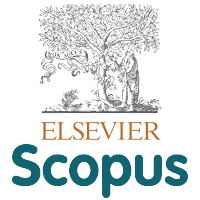Activity of Bamboo Wulung’s Smoke Gigantochloa atroviolace againts Subterranean Termites and Fungi Attack
Abstract
Termites are plants, housing, furniture, and building pests. Termite control has been carried out using synthetic pesticides that are harmful to the environment and human health. Innovation in controlling termites and fungi is required for the preservation of wood and furniture. The aim of this study was to analyze the use of bamboo Wulung’s (Gigochocha atroviolace) smoke for controlling termites and fungi attacks. The methods used were the manufacture of bamboo’s smoke, a test of preference for termites, and mortality of termites. The results showed that liquid smoke at 450oC was effective for controlling termites and fungi. The smoke of bamboo Wulung with a concentration of 10% can control C. formosanus termites. It showed 100% mortality within 14 days, while the smoke of bamboo Wulung with a concentration of 5% showed 100% mortality of R. speratus within 14 days. Bamboo smoke at pyrolysis temperature 450oC and a concentration of 2.0% can prevent the growth of T. vesicolor fungus while effective at the same concentration for F. palustris. Bamboo smoke can prevent the growth of T. vesicolor mushrooms at a liquid smoke temperature of 450oC with a concentration of 2% and the fungus F. palustris at a concentration of 2.0%.
Keywords
Full Text:
PDFReferences
Abnisa, F., Arami-Niya, A., Wan Daud, W. M. A., Sahu, J. N., & Noor, I. M. (2013). Utilization of oil palm tree residues to produce bio-oil and bio-char via pyrolysis. Energy Conversion and Management, 76, 1073–1082. crossref
Adfa, M., Kusnanda, A. J., Saputra, W. D., Banon, C., Efdi, M., & Koketsu, M. (2017). Termiticidal activity of Toona sinensis wood vinegar against Coptotermes curvignathus holmgren. Rasayan Journal of Chemistry, 10(4), 1088–1093. crossref
Bläske, V.-U., & Hertel, H. (2001). Repellent and toxic effects of plant extracts on subterranean termites (Isoptera: Rhinotermitidae). Journal of Economic Entomology, 94(5), 1200–1208. crossref
de Souza Araújo, E., Pimenta, A. S., Feijó, F. M. C., Castro, R. V. O., Fasciotti, M., Monteiro, T. V. C., & de Lima, K. M. G. (2018). Antibacterial and antifungal activities of pyroligneous acid from wood of Eucalyptus urograndis and Mimosa tenuiflora. Journal of Applied Microbiology,124(1), 85–96. crossref
Faisal, M., Utari, S., Hayvia, Z., & Maulana, I. (2019). A preliminary study of the utilization of Cu(II) modified liquid smoke to inhibit the activity of white-rot fungi (Schizophyllum commune Fr) in a pinewood in-vitro. International Journal of GEOMATE, 17(61), 56–61. crossref
Hadi, Y. S., Efendi, M., Massijaya, M. Y., Arinana, & Pari, G. (2016). Technical note: Subterranean termite resistance of smoked glued laminated lumber made from fast-growing tree species in Indonesia. Wood and Fiber Science, 48(3), 211–216. Retrieved from website
Hadi, Y. S., Nurhayati, T., Jasni, Yamamoto, H., & Kamiya, N. (2010). Smoked wood resistance against termite. Journal of Tropical Forest Science, 22(2), 127–132. Retrieved from pdf
Hadi, Y. S., Nurhayati, T., Jasni, Yamamoto, H., & Kamiya, N. (2012). Resistance of smoked wood to subterranean and dry-wood termite attack. International Biodeterioration & Biodegradation, 70, 79–81. crossref
Montazeri, N., Oliveira, A. C. M., Himelbloom, B. H., Leigh, M. B., & Crapo, C. A. (2013). Chemical characterization of commercial liquid smoke products. Food Science & Nutrition, 1(1), 102–115. crossref
Nandika, D., Rismayadi, Y., & Diba, F. (2015). Rayap: Biologi dan pengendaliannya. (N. Mubin, Ed.) (2nd ed.). Surakarta: Muhammadiyah University Press. Retrieved from website
Ni, J., & Tokuda, G. (2013). Lignocellulose-degrading enzymes from termites and their symbiotic microbiota. Biotechnology Advances, 31(6), 838–850. crossref
Oramahi, H. A., & Yoshimura, T. (2013). Antifungal and antitermitic activities of wood vinegar from Vitex pubescens Vahl. Journal of Wood Science, 59(4), 344–350. crossref
Oramahi, H. A., Yoshimura, T., Diba, F., Setyawati, D., & Nurhaida. (2018). Antifungal and antitermitic activities of wood vinegar from oil palm trunk. Journal of Wood Science, 64, 311–317. crossref
Subekti, N. (2019). Rayap: Biologi dan pengendaliannya. Surakarta: UNS Press.
Subekti, N., Fibriana, F., Widyaningrum, P., & Adfa, M. (2017). Determination of the major compounds in the extract of the subterranean termite Macrotermes gilvus Hagen digestive tract by GC-MS method. The Ukrainian Biochemical Journal, 89(4), 77–82. crossref
Subekti, N., Widiyaningrum, P., Nurvaizah, I., & Mar’Ah, R. (2019). Effective control of subterranean termite Coptotermes curvignathus using n-hexane and ethyl acetate from gaharu (Aquilaria malaccensis). Systematic Reviews in Pharmacy, 10(2), 31–33. Retrieved from website
Susilowati, D., Subekti, N., & Bintari, S. H. (2018). The potential of microbial symbionts Macrotermes gilvus Hagen termite gut as degrading agents of cellulose in bioethanol production. Biosaintifika: Journal of Biology & Biology Education, 10(2), 395–400. crossref
Syahidah, & Subekti, N. (2019). Biological activity of mangrove leaves extract (Rhizophora sp.). In The 1st Biennial Conference on Tropical Biodiversity (Vol. 270, p. 012051). Makassar, ID: IOP Conference Series: Earth and Environmental Science. crossref
Widyastuti, S. M., Riastiwi, I., & Suryanto, P. (2019). Tree health typology of homegardens and dry fields along an altitudinal gradient in Kulon Progo, Indonesia. AGRIVITA Journal of Agricultural Science, 41(1), 183–194. crossref
Yoshimura, T., Imamura, Y., & Takahashi, M. (2003). Attacks on foam insulation materials by Coptotermes formosanus Shiraki and Reticulitermes speratus (Kolbe). Japanese Journal of Environmental Entomology and Zoology, 14(4), 213–221. crossref
DOI: http://doi.org/10.17503/agrivita.v42i3.2761
Copyright (c) 2020 The Author(s)

This work is licensed under a Creative Commons Attribution-NonCommercial 4.0 International License.








